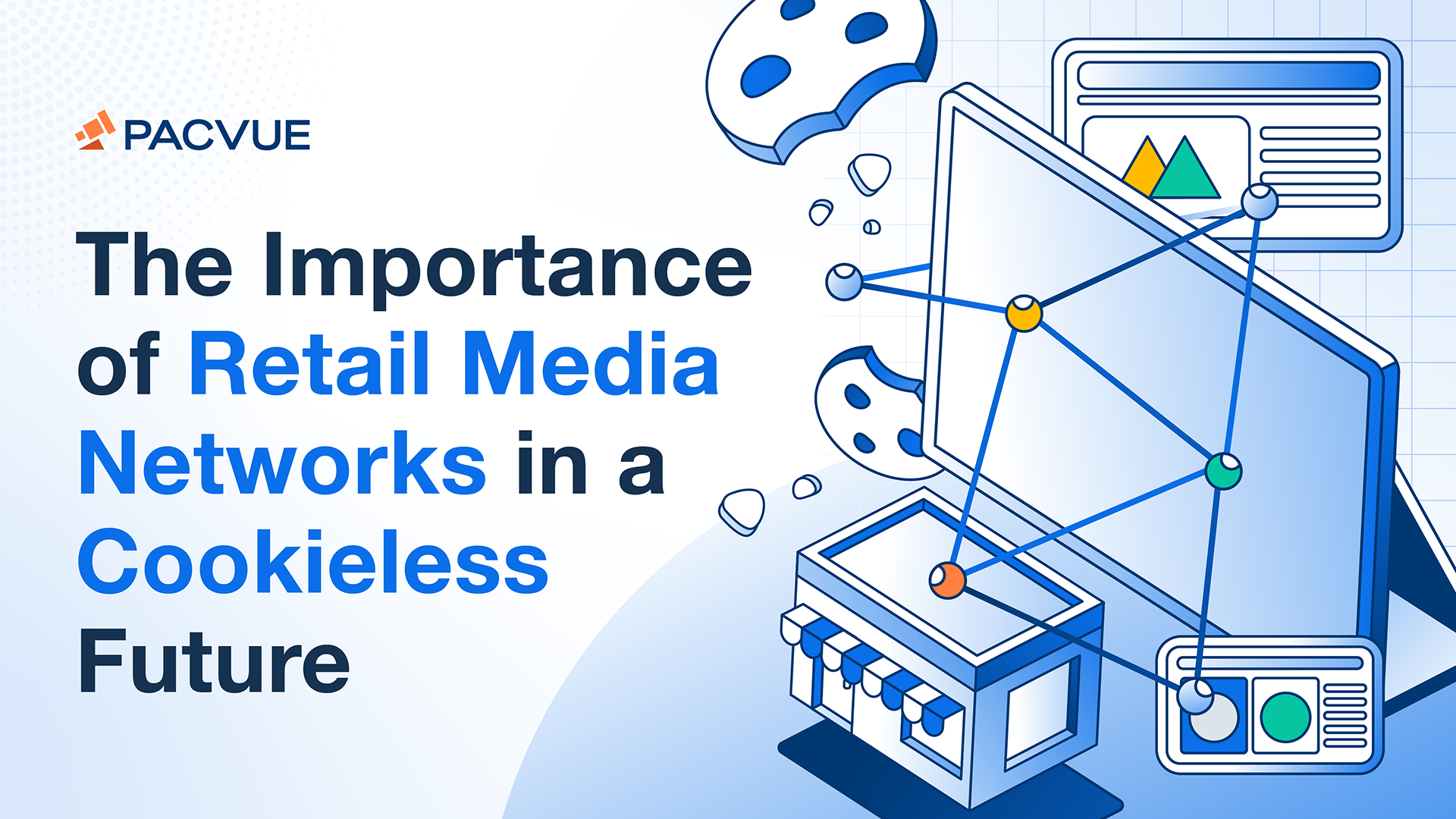Cookies play a crucial role in digital advertising, helping brands track user behavior, personalize ads, and measure ad performance. Cookies help us deliver relevant ads to shoppers based on their browsing history, preferences, and previous interactions with websites. In this way, we can target and retarget shoppers who are in the market to buy our products. But third-party cookies won’t be around for much longer. Google’s plans to phase out third-party cookies are encouraging brands to explore new ways to leverage first-party data. Third-party cookie deprecation has also prompted a shift towards retail media networks (RMN) as an alternative advertising platform for brands.
Why Retail Media Networks are Emerging as the Perfect Solution for Advertisers
Since third-party cookies will no longer be a sustainable data source, what choices do brands and retailers have when creating audience target groups and launching their digital advertising campaigns? Retail media networks have emerged as one of the fastest-growing digital advertising channels. And the best part? They rely primarily on first-party data.
The Rise and Rise of Retail Media Networks
“Worldwide retail media ad spending is on track to increase by nearly $100 billion between 2020 and 2025. Its 21.8% rise this year will outpace growth rates in nearly all other forms of ad spending.” *
More and more retailers are launching their own retail media networks for several reasons, but mainly to:
- Monetize their customer data by offering advertisers targeted opportunities.
- Create digital traffic by redirecting shoppers, who’ve seen an ad while browsing elsewhere, back to the retailer’s site.
- Keep valuable consumer insights in-house, using it to improve their marketing strategies and product offerings.
- Enhance the path-to-purchase experience by providing more relevant ads to shoppers.
*Source: eMarketer, 2024.
Why Brands Are Shifting Advertising Budgets to Retail Media
Brands are increasingly shifting their budgets to retail media networks because retailers can offer precise targeting using first-party data they collect from website visits, transactions, customer feedback, and subscriptions.
Retail media networks aren’t exclusively for brands that sell on the retailer’s website. Non-endemic brands can access retail media too, and reach customers whose lifestyle and buying choices indicate they’re a worthy target.
How Non-endemic Brands Can Promote Products with Amazon Ads
Chevrolet launched a successful ad campaign on Amazon to promote its 2021 SUVs in Mexico. They used Amazon’s ad products, targeting tools, and insights to create engaging multimedia content. The campaign featured video ads, custom ads, and Fire Tablet wake screen ads that targeted tech-savvy families looking for new vehicles.
Chevrolet saw significant increases in customer engagement and brand awareness. The campaign drove a 93% increase in detail page views and a 55% rise in searches for Chevrolet vehicles on Amazon.
Five Reasons Why Brands Are Favoring Retail Media Networks Over Other Digital Ad Platforms
#1: The Emergence of ‘Walled Gardens’
A ‘walled garden’ is a controlled digital ecosystem in which retailers like Amazon or Walmart can store their data and restrict access and interactions within its ‘walls’. Offering access to paying advertisers opens up new, granular targeting strategies for brands.
#2: First-Party Data and Granular Audience Targeting
Access to first-party data is a key incentive for brands looking to make their targeting accurate and reduce wasted spend. This kind of granular audience targeting meets privacy regulations and provides data that is equally or more relevant than third-party data.
#3: Amazon’s Data Clean Rooms
Brands that gather their own data can benefit from the data clean rooms offered by Amazon and others. In these secure digital environments, you can upload, mingle, and analyze multiple sources of data, including the retailer’s data (e.g. from Amazon Marketing Cloud). Importantly, you can share insights without exposing the underlying data to the retailer or anyone else. For example, two parties collaborating on a joint marketing program can implement, monitor, and analyze their campaign without seeing each other’s data.
#4: Clear Reporting
DSPs owned by retailers also offer clear and deep insights that allow brands to continually improve the performance of their campaigns, maximizing ROAS. They also allow you to track the path to purchase from the moment of advertising engagement all the way to the point of purchase, making it easier to report on attribution.
#5: The Impact of Connected TV
Connected TV (CTV) presents advertisers with opportunities to reach audiences through targeted ads, tailored to their viewing habits and preferences. It has revolutionized advertising because it offers the reach of traditional TV with the precision of digital targeting: you get detailed analytics that allow you to continuously tune your campaign. You can also buy CTV advertising programmatically which helps you manage budgets better and reduce your overall costs.
Amazon’s Connected TV Strategy
Grasping the extent of the opportunity, Amazon is significantly scaling its CTV offering by:
- Continually investing and expanding its Prime Video service to grow the audience and increase engagement.
- Integrating its advertising technology with its streaming content, opening up targeted advertising opportunities on platforms like Amazon Fire TV.
- Upgrading its Fire TV devices to make sure they’re compatible with newer technologies and higher video quality standards.
- Pushing its CTV products into new markets around the world, expanding its reach beyond the United States.
Walmart Expands its Connected TV Offering Too
In February 2024, Walmart announced its acquisition of VIZIO, “to accelerate the growth of Walmart Connect” (Walmart’s Retail Media Network in the U.S.). VIZIO’s Smartcast Operating System offers viewers a wide range of streaming options right out of the box; they can stream content from popular apps such as Netflix, Hulu, and YouTube directly on their TVs.
For advertisers, Walmart and VIZIO’s collaboration opens up several opportunities:
- Better targeting thanks to SmartCast’s access to user data and viewing habits. This allows for more personalized ad experiences, potentially increasing the effectiveness of ad campaigns.
- The ability to engage cross-platform, because SmartCast supports a variety of streaming services and apps. You can capture viewers’ attention whether they’re watching traditional TV shows, streaming videos, or using apps.
- Ads can be interactive due to SmartCast’s innovative approach to voice commands and controls.
- Data-led insights help you refine strategies and optimize ad spend.
Three Ways Your Brand Can Prepare for a Future Without Cookies
#1: Shift programmatic budgets to retail media networks and connected TV.
Retail media networks and connected TV both offer compelling reasons to apportion a larger share of your programmatic advertising budget, including:
- Enhanced targeting and personalization with access to rich, first-party data. This level of personalization isn’t always possible with traditional programmatic advertising that often relies on broader, third-party data sets.
- Improved measurement and attribution mean you can directly link ads to purchases. In broader programmatic advertising, this closed loop reporting is harder to achieve because the path from ad exposure to purchase might not be so direct or clear.
- Increased relevance and engagement when you place ads in a shopping context. It makes ads relevant to consumers who are most likely to buy your products.
- The growing audiences on connected TV can’t be ignored. CTV allows you to serve high-quality video ads more effectively than traditional TV advertising because of its precise targeting.
- Greater efficiency and ROI compared to traditional programmatic channels. Because of RMNs advanced targeting, your ads are more likely to reach and resonate with the intended audience, leading to higher ROI.
- CTV allows for innovative formats using voice technologies that make ads interactive; an innovation that traditional television advertising can’t match.
- Gain strategic advantage over competitors who rely on more traditional advertising platforms.
#2 Take advantage of rich data sets like Amazon Marketing Cloud (AMC) with large DSP networks.
Amazon Marketing Cloud (AMC) offers a powerful data resource. When you combine it with the reach of large DSP networks, you have the tools to build highly targeted and efficient advertising campaigns. Here are just some of the ways you can leverage Amazon Marketing Cloud (AMC) data within large Demand-Side Platforms (DSP) to gain advantage:
- The rich data set within AMC allows you to deeply understand your target audiences including their purchasing patterns and browsing activities.
- Using DSP, you can adjust your strategies in real time, based on what is and isn’t working. This improves your engagement and conversion rates and increases ROI.
- You can seamlessly integrate AMC data with large DSP networks, using your Amazon insights across a wide range of media buying platforms.
- You can make more informed decisions based on KPIs including the most effective ad placements and the best timing for campaigns, as well as insights into the competitive landscape.
- Your wasted ad spending will be reduced thanks to better targeting. This means you can fund more experiments with new formats or channels, or double down on your existing campaigns.
#3 Reduce complexity by consolidating your advertising planning, implementation and monitoring in one platform.
Running multiple advertising campaigns — including search advertising as well as DSP — on a range of digital media, is operationally complex for any marketing team. For advertising agencies, it becomes impossible to achieve stellar results for every account without the help of Pacvue’s technologies. Pacvue provides the insights and automates the processes that allow you to set up and run ad campaigns, quickly and at scale.
By consolidating advertising campaigns under Pacvue’s unified commerce platform, you can make huge strides when it comes to streamlining, decision-making and improving ROI. And all this in real time. With Pacvue you get:
- A unified dashboard that allows you to compare like-for-like across different platforms without toggling between platforms like Walmart, Amazon and many more. By aggregating data from multiple sources, Pacvue gives you unique insights that identify trends, compare performance benchmarks, and gain insights into the competitive landscape.
- Comprehensive analytics and reporting tools that are easy to use. You can dive deep into the data captured by retail media networks and DSPs via the Pacvue lens. Pacvue translates this data into intuitive visualizations that help you achieve better outcomes.
- Simplified analytics from complex data sources. If you lack the technical skills to navigate the nuances of each ad platform or idiosyncrasies of complex data technologies (e.g., AMC data is stored in an SQL database), Pacvue will query the data and do the hard work for you.
- Automate your campaign management across multiple platforms by creating rules around bid adjustments. This level of automation helps you efficiently manage large-scale campaigns and improve ROAS. These and other time-saving capabilities in Pacvue, such as automated dayparting, make Pacvue an invaluable tool when running complex advertising strategies during peak events such as Prime Day.
- Team collaboration so that you, your team members and your agency can work on campaigns simultaneously.
Conclusion
As we move closer to a cookie-less future in digital advertising, retail media networks and connected TV are emerging as pivotal platforms for brands to reach their target audiences. They help you to be more precise in your targeting by analyzing retailers’ rich, first-party data sets. This shift allows you to engage with consumers in a more personalized way. It also means you’re able to track and measure the impact of your campaigns directly through purchases.
Whether you’re a manufacturer or an advertising agency starting out with retail media networks, or you’ve outgrown your advertising processes and want to find a way to operate more efficiently, we’d love to hear your story and show you how Pacvue can help you raise your game.













